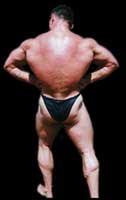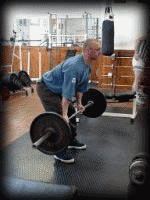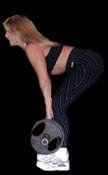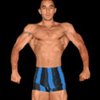What Is Hard Training?
 I think that in competitive bodybuilding, wide and thick lats, accompanied by well-developed legs, are a sign of hard training. In order to train your back effectively, you'll need to do some sort of combination of pull-down movements and rowing movements. I'll say this now in order to avoid repetitiveness: with every exercise that you perform in a back workout, ALWAYS arch and flex your lower back, keep your head up, stick your chest out, keep your shoulders rolled back, and pull with your elbows. We'll begin with pull-down movements.
I think that in competitive bodybuilding, wide and thick lats, accompanied by well-developed legs, are a sign of hard training. In order to train your back effectively, you'll need to do some sort of combination of pull-down movements and rowing movements. I'll say this now in order to avoid repetitiveness: with every exercise that you perform in a back workout, ALWAYS arch and flex your lower back, keep your head up, stick your chest out, keep your shoulders rolled back, and pull with your elbows. We'll begin with pull-down movements.
Pull-ups are the bread and butter for back training. If you are not strong enough to do a pull-up, start with cable pull-downs and work your way up to it. However, if you have a workout partner, do pull-ups for forced reps until you can do it on your own. You'll need to pull yourself up to the bar to where the bottom of your chin or top of your chest touches the bar. I never touch the bar with the back of my neck. Keep in mind that how you do this exercise is what will make the difference.
Using Your Back
Use your back to pull, not your biceps. Your legs should be bent at a ninety-degree angle, they should be crossed, and should never move anytime during the set. Most people avoid doing this and swing their legs everywhere and end up not even using their lats to pull. Avoid squeezing with your traps, which is very easy to do if you are pulling with your biceps. Once you've mastered pull-ups, start adding additional weight by utilizing a weight belt. Take caution, however, in that you do not sacrifice form for weight.
If you absolutely cannot do pull-ups, get on a cable pull-down instead. The movement is exactly the same as a pull-up. Lean back slightly before you start your set. Avoid rocking your body back and forth with the repetitions. Control the weight and pull with your elbows. Doing behind-the-neck pulldowns is a good idea from time to time, but I would wait until you are deeper into your workout. To perform: do not lean back, sit straight up, and pull the weight directly downwards and touch the bar to your neck. Your upper-body should remain motionless throughout the set.
You can use many other types of bars to do pull-downs with that are also very effective. For example, the V-bar is extremely good for hitting the middle back. Also, you can adjust the width of your grip every set with a straight bar. You can even hold the bar with a suppinated curl-grip and effectively hit your back.
Rowing Movements
 The rowing movements are a little more in-depth. First is the simple bent-over barbell row. You can perform this movement with either a pronated or suppinated grip. I always hold the bar with a grip that is wide enough so that I just miss hitting my sides with my hands at the top. Before you begin your set, your feet should be less than shoulder width apart, and make sure your knees are slightly bent.
The rowing movements are a little more in-depth. First is the simple bent-over barbell row. You can perform this movement with either a pronated or suppinated grip. I always hold the bar with a grip that is wide enough so that I just miss hitting my sides with my hands at the top. Before you begin your set, your feet should be less than shoulder width apart, and make sure your knees are slightly bent.
Do not bend over to a point that you are completely parallel with the floor, but enough to where you feel your lats pulling as the weight hangs.
Pull the weight to the middle of your stomach and let it down to a point in front of your knees. Avoid touching your knees with the weight. A common problem with rowing in general is that people tend to lose their form at the very top of the rep, remember what I said in the beginning and you should be fine.
One-arm dumbbell rows are very good for isolating one lat at a time. Many people use a flat bench for this exercise, however, I think that by doing this, your upper body is parallel with the floor, and personally, I cannot get a good feel in my back like that. Therefore, I like to get a dumbbell, and place my nonworking hand on a heavier racked dumbbell so that my body makes an angle with the floor (just like on barbell rows). If you place your hand on a lighter dumbbell, the dumbbell might move during your set, and then you're in trouble. Start with the dumbbell inline with your head, and pull the weight back toward your waist. Pull the weight as high as you can without rotating at the waist.
Seated rows are also a good movement. I use the V-bar for this movement, but you can also use a straight bar with whatever type of grip that you want. Start with your knees slightly bent and do not lean forward after you have begun your set. Pull the weight to the bottom of your abs and squeeze like hell. Most people have a problem with this movement because they do not do the things that I have listed in paragraph one.
T-Bar rows are a favorite of many because it is a major mass builder. However, it is hard to find a good T-Bar in a gym for some reason. Most gyms have the pseudo T-Bar where you lay on a pad and pull the weight up. A real T-Bar requires that you stand, not lay. If you have a good T-Bar at your gym, I encourage you to use it. The form that you should use is exactly the same as a bent-over barbell row.
Deadlifts
Finally, the mother of all back exercises, deadlifts. This exercise is so effective for overall strength and size, it is ridiculous. As a matter of fact, it is somewhat difficult to decide what workout is good for including deadlifts. I do these on back day because that is where I feel it the most. Stand anyway that you want. I started out using a narrow stance, but I think that incorporated too much of my lower back and legs. 
I switched to a very wide stance (sumo stance) and now I can really blast my back muscles. The key, as with every other back exercise, is to keep your form throughout the entire set. Deadlift at the beginning or end of your workout, it really doesn't matter because it hurts all the same. I prefer to deadlift at the very end of my workout because it is easier to use my back since I already have a pump.
As you can see, back training is very involved. Form is extremely crucial, it is easily the most important factor in training back. Now, for all of you who have made it this far, I'm going to let you in on a little secret that will force you to pull with your lats even more. For every back exercise, use a thumbless grip, this way you will take your biceps almost completely out of the picture. True, you will have to use wrist straps a little bit more, but use them only when necessary. Here's a great back-blasting workout:
| Weighted pull-ups | 12, 10, 8, 8 |
| Bent-over barbell rows | 10, 8 |
| Curl-grip pull-downs | 12, 10 |
| V-bar pull-downs | 12, 10 |
| Seated Rows | 10, 8 |
| Deadlifts | 12, 10, 8 |
Good Luck!
